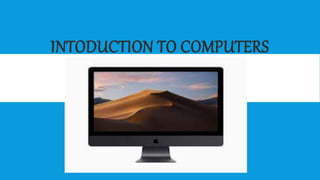Introduction to computer
•Download as PPTX, PDF•
2 likes•166 views
Introduction to computer
Report
Share
Report
Share

Recommended
More Related Content
What's hot
What's hot (20)
Similar to Introduction to computer
Similar to Introduction to computer (20)
Chapter 1.pdf@#$%^&*()+×÷=/_€£¥₩1234/_7890-'cv bnmasdf

Chapter 1.pdf@#$%^&*()+×÷=/_€£¥₩1234/_7890-'cv bnmasdf
Introduction to Computer , types of computer,classification of computer What ...

Introduction to Computer , types of computer,classification of computer What ...
More from Forum of Blended Learning
More from Forum of Blended Learning (20)
Artificial-Intelligence-Productivity-Engine-for-Economic-Growth (1).pptx

Artificial-Intelligence-Productivity-Engine-for-Economic-Growth (1).pptx
Understanding-Artificial-Intelligence-in-Research (1).pptx

Understanding-Artificial-Intelligence-in-Research (1).pptx
Conventional-and-Contemporary-Trends-in-Educational-Research.pptx

Conventional-and-Contemporary-Trends-in-Educational-Research.pptx
Educational-Technology-Optimizing-Learning-in-the-21st-Century.pptx

Educational-Technology-Optimizing-Learning-in-the-21st-Century.pptx
Maths Co-curricular Activities : Mathematics Laboratory

Maths Co-curricular Activities : Mathematics Laboratory
Recently uploaded
https://app.box.com/s/x7vf0j7xaxl2hlczxm3ny497y4yto33i80 ĐỀ THI THỬ TUYỂN SINH TIẾNG ANH VÀO 10 SỞ GD – ĐT THÀNH PHỐ HỒ CHÍ MINH NĂ...

80 ĐỀ THI THỬ TUYỂN SINH TIẾNG ANH VÀO 10 SỞ GD – ĐT THÀNH PHỐ HỒ CHÍ MINH NĂ...Nguyen Thanh Tu Collection
Recently uploaded (20)
Diuretic, Hypoglycemic and Limit test of Heavy metals and Arsenic.-1.pdf

Diuretic, Hypoglycemic and Limit test of Heavy metals and Arsenic.-1.pdf
Including Mental Health Support in Project Delivery, 14 May.pdf

Including Mental Health Support in Project Delivery, 14 May.pdf
NO1 Top Black Magic Specialist In Lahore Black magic In Pakistan Kala Ilam Ex...

NO1 Top Black Magic Specialist In Lahore Black magic In Pakistan Kala Ilam Ex...
Simple, Complex, and Compound Sentences Exercises.pdf

Simple, Complex, and Compound Sentences Exercises.pdf
Michaelis Menten Equation and Estimation Of Vmax and Tmax.pptx

Michaelis Menten Equation and Estimation Of Vmax and Tmax.pptx
Observing-Correct-Grammar-in-Making-Definitions.pptx

Observing-Correct-Grammar-in-Making-Definitions.pptx
80 ĐỀ THI THỬ TUYỂN SINH TIẾNG ANH VÀO 10 SỞ GD – ĐT THÀNH PHỐ HỒ CHÍ MINH NĂ...

80 ĐỀ THI THỬ TUYỂN SINH TIẾNG ANH VÀO 10 SỞ GD – ĐT THÀNH PHỐ HỒ CHÍ MINH NĂ...
HMCS Vancouver Pre-Deployment Brief - May 2024 (Web Version).pptx

HMCS Vancouver Pre-Deployment Brief - May 2024 (Web Version).pptx
Andreas Schleicher presents at the launch of What does child empowerment mean...

Andreas Schleicher presents at the launch of What does child empowerment mean...
Introduction to TechSoup’s Digital Marketing Services and Use Cases

Introduction to TechSoup’s Digital Marketing Services and Use Cases
Introduction to computer
- 2. WHAT IS A COMPUTER? A computer is an electronic device, operating under the control of instructions stored in it’s own memory, that can accept data, process the data according to specified rules, produce results and store the results for further use.
- 3. CHARACTERS OF A COMPUTER Basic characters of a computer: Speed: The computer can work very fast. It takes only a few seconds for calculations that we take hours to complete. Accuracy: The degree of accuracy in a computer is very high. Every calculation and details are performed with the same accuracy.The errors in the computer are due to human and inaccurate data.
- 4. Diligence: A computer is free from tiredness, lack of concentration, fatigue, etc. It can work for hours without any errors. Versatility: A computer can perform completely different types of tasks.You may use your computer for prepare payroll slips and the next moment you may use it for paying electricity bills. Power of remembering: Any information can be stored and recalled, for any number of years.
- 5. No IQ: A computer is a machine and it cannot do any work without instructions. It is you who decide what to do and in what sequence. No feelings: it does not have feelings, emotions, taste, knowledge and experience.Thus it does not get tired after long hours of work. It does not distinguish between users. Storage: a computer has a large memory where it stores large data.You can also store data in secondary devices like floppies, which can be carried to other computers.
- 6. CLASSIFICATION OF COMPUTERS On the basis of size On the basis of functionality On the basis of data handling
- 7. CLASSIFICATION ON THE BASIS OF SIZE Super computers: The most high performing system compared to general-purpose computer.They play a major role in computing tasks in various fields, including quantum mechanics, weather forecasting, climate research, etc.
- 8. Mainframe computers: These are used by big organisations for bulk data processing such as statics, census data processing, transaction processing, etc.
- 9. Mini Computers: These computers where sold at much cheaper prices than the main frames.They were designed for human interaction and communication. Later they became very popular for personal uses with evolution.
- 10. Micro Computers: small, relatively inexpensive computer with a microprocessor as its CPU. Main frame computers and Mini computers were expensive and hard to maintain.These actually formed a foundation for micro computers. eg: tablets and smartwatches.
- 11. CLASSIFICATION BASEDON FUNCTIONALITY Servers: dedicated computers which are based on the services they provide to the clients. Eg: security server, database server Workstation: These are primarily used by single user at a time.They are the ones we use in our day to day personal / commercial work Information appliances: Basically the ones designed to perform a limited set of tasks like basic calculations, browsing the internet, playing multimedia. Eg: mobile devices
- 12. CLASSIFICATION BASED ON DATA HANDLING Analog: a form of computer that uses the changeable aspects of physical facts such as mechanical and electrical to model the problem being solved. Digital: a computer that performs calculations and logical operations with quantities represented as digits. Hybrid: processes both Analog and Digital data. It accepts Analog signals and converts them to digital and processes them in digital forms.
- 13. THANK YOU!
